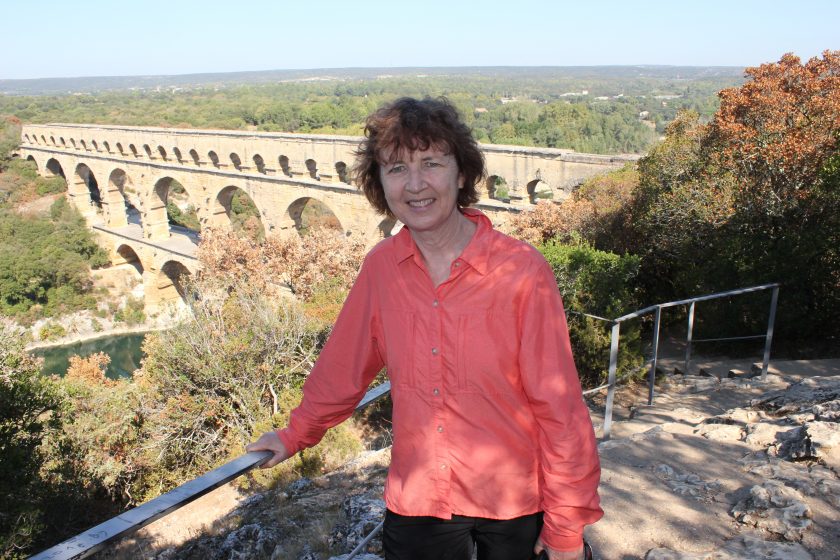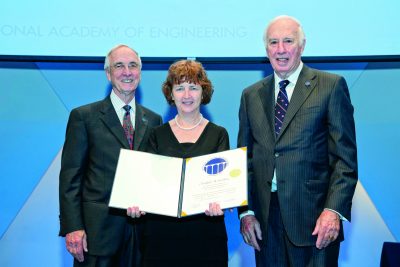Scientist Profile: Bridget Scanlon
November 20, 2017

by John Holden
Bridget Scanlon’s contribution to understanding our most precious resource cannot be overstated. As a world-leading authority on water research, her career has been characterized by a commitment to data as well as innovative approaches that cut across disciplines.
During her 30-year career at the Bureau of Economic Geology, Scanlon has published over 100 articles in numerous peerreviewed journals, such as Groundwater, Water Resources Research, and Environmental Science & Technology. She has served on National Academy of Sciences committees, been involved with U.S. Department of Energy scientific endeavors, and has been a member of the NASA GRACE science team, a group dedicated to using satellite data to study Earth.
In 2016, she was elected as a member of the National Academy of Engineering, one of the highest professional honors a scientist can receive. Also in that same year, she received the National Ground Water Association’s M. King Hubbert Award for major science contributions to the knowledge of groundwater. Recently, she was appointed to the Jackson School’s William L. Fisher Endowed Chair in Geological Sciences, a distinction that recognizes research scientists, research professors or faculty members for their excellence in research, teaching and service.
“The Bureau of Economic Geology is fortunate to have a research scientist with the dedication, expertise and vision of Dr. Bridget Scanlon,” said bureau Director Scott W. Tinker.
“Bridget is widely considered one of the foremost authorities on water resources. She is passionate about her work and what it means to the conservation and wise utilization of water sources in Texas, nationally and globally. I’m honored to call Bridget a colleague and friend.”
WATER, WATER EVERYWHERE
While Scanlon is widely versed in the elements that impact water usage, storage and conservation, she is particularly active in certain research areas: studies of groundwater recharge; the impact of climate extremes and land-use changes on hydrologic processes; water use and availability related to energy; and use of underground aquifers as water storage facilities.

Born in County Kerry, Ireland, Scanlon first studied geology at Trinity College in Dublin and also worked as a field assistant with the Geological Survey of Ireland. This field work formed the basis of her 1983 master’s in geology undertaken at the University of Alabama. Its focus on the hydrogeology of karst landscapes was a preamble to her chemical and physical work as a Ph.D. student at the University of Kentucky in the karst central Bluegrass Region.
After her Ph.D., she spent a year working for the S.S. Papadopulos consulting firm in Washington, D.C., and then interviewed for positions in research and teaching in various U.S. universities.
“That’s how I ended up in Texas,” she said. Scanlon was first offered a position as research associate at the bureau in 1987. Her decision to remain for three decades is due mainly to the independence afforded to active researchers and the avenues such flexibility allows for collaboration across disciplines.
“The range of things we do at the bureau cannot be understated,” she said. “From satellite to deep subsurface, we go the whole gamut. “The bureau model has always impressed me,” she stressed. “They really promote collaboration. Every project is a team effort. This is quite different from working in traditional university departments where professors are frequently lone rangers in their respective fields. Fostering a collaborative spirit is so beneficial, particularly from a research perspective.”
BEYOND OIL & GAS
It is sometimes assumed the bureau is focused solely on oil and gas research and funded almost exclusively by major private energy producers. This is a misconception, and Scanlon’s tenure at the bureau is a testament to how diverse the research can be.
“When I first started here, my focus wasn’t on oil and gas at all, but various environmental issues, including low-level radioactive waste disposal,” she said. “Over the years, the bureau has worked with the Texas Water Development Board, Texas Commission on Environmental Quality, the EPA, and is currently conducting a major study into carbon sequestration with the support of the Department of Energy More recently, however, Scanlon has found her expertise becoming increasingly relevant to oil and gas, given how central water is to the process of hydraulic fracturing.
“There is a lot of concern over the large amounts of water needed in order to hydraulically fracture wells in the first place,” she said. “Given its high premium in a state like Texas, much attention is focused on where water can be sourced to service major plays where hydraulic fracturing is being conducted.”
Another challenge is managing the water produced as a byproduct of hydraulic fracturing along with oil and gas. This “produced” water needs to be disposed of in some way, and there is often a lot of it.
“The U.S. produces about 10 barrels of water for each barrel of oil,” she stated.
Between the water used in hydraulic fracturing operations and the water produced as a result of those operations, water management is a critical issue for industry. However, it is important to consider water use for the energy sector in a broader context with irrigated agriculture being a major water user in many semiarid regions.
“There is no one size fits all model,” Scanlon said. “Each play has its own particular set of variables that must be assessed individually. By studying the details of each play, then putting all those pieces together and taking a step back, we then begin to understand the broader picture. For me, this approach to research has frequently led to the discovery of workable solutions to the many challenges faced when it comes to water supply and demand.”
Back to the Newsletter